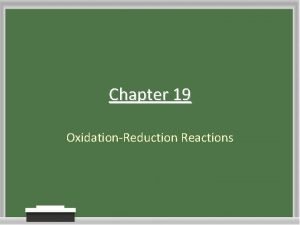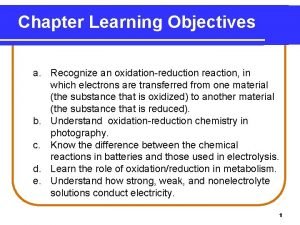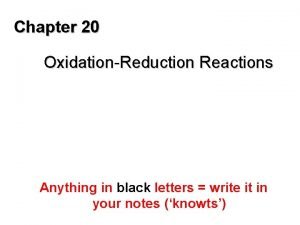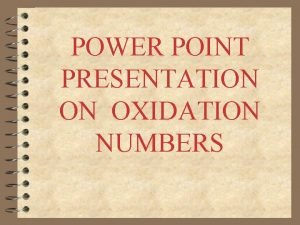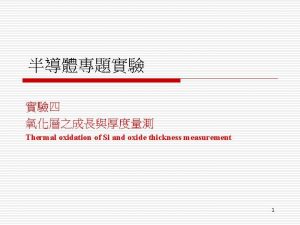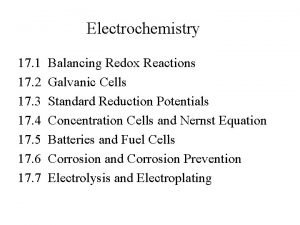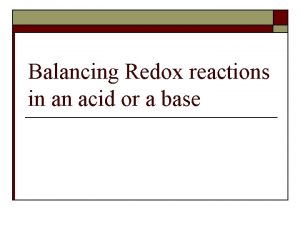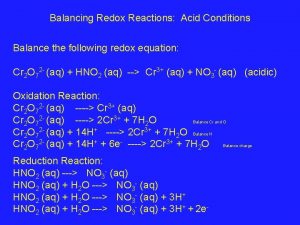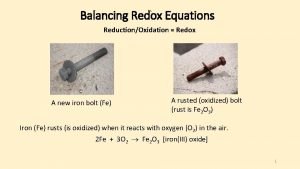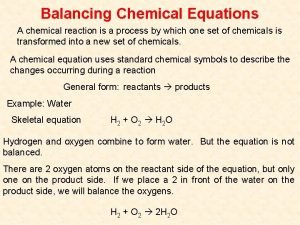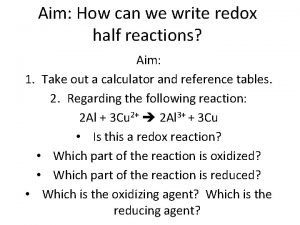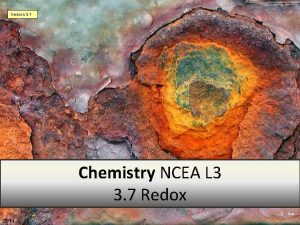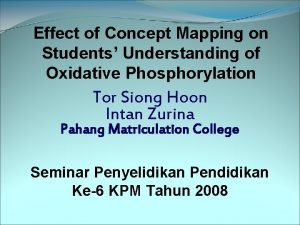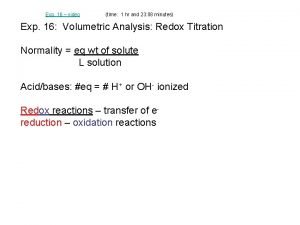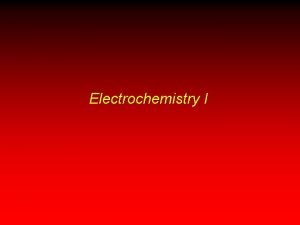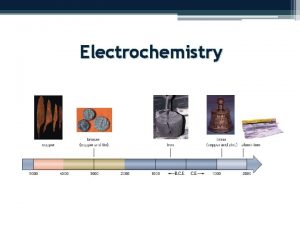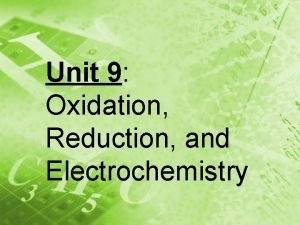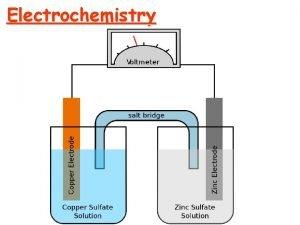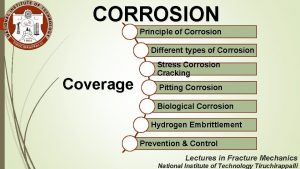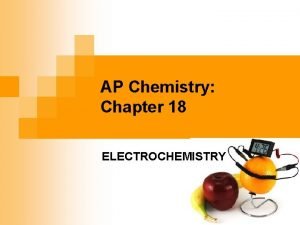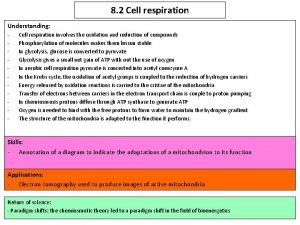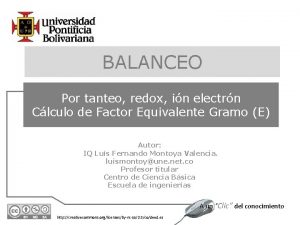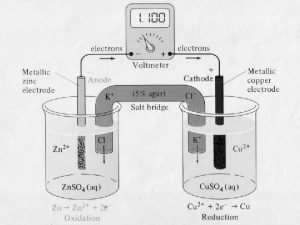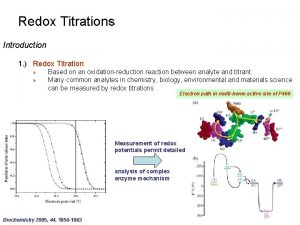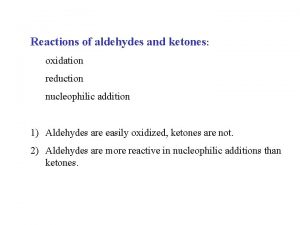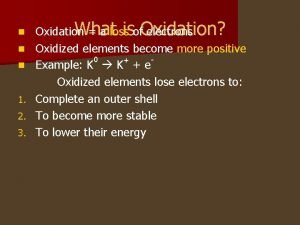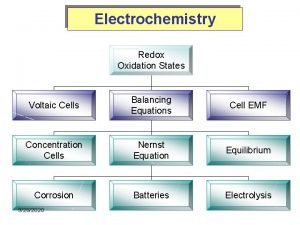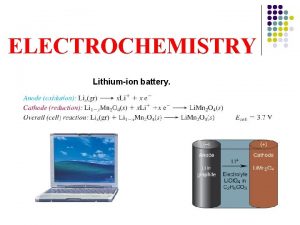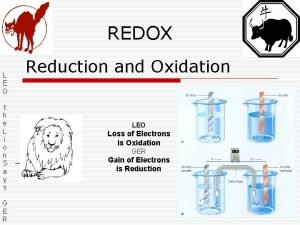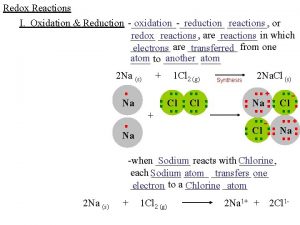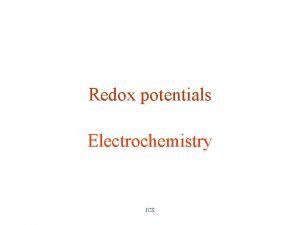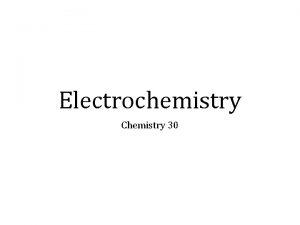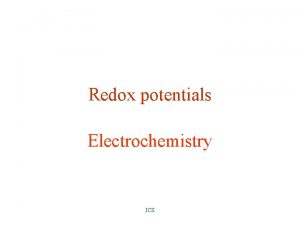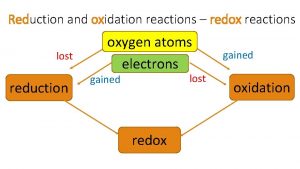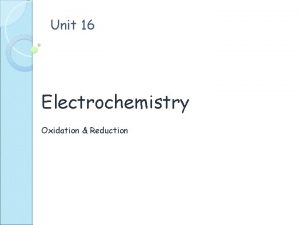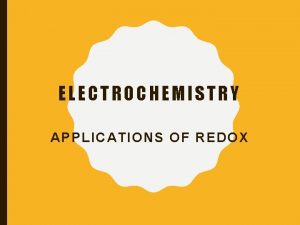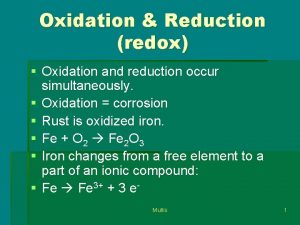Electrochemistry Chapter 20 Redox Reactions n Reduction Oxidation



















































![Concentration Cells n n E°cell = 0 [reactants]<[products] Concentration Cells n n E°cell = 0 [reactants]<[products]](https://slidetodoc.com/presentation_image_h2/695cd63381fe64a95a1d69a5ab056184/image-52.jpg)





- Slides: 57

Electrochemistry Chapter 20

Redox Reactions n Reduction – Oxidation, or redox, involves the transfer of electrons n Reduction – gain of electrons n Oxidation – loss of electrons

Redox Reactions n LEO the lion goes GER n Lose Electrons Oxidation n Gain Electrons Reduction

Redox Reactions n OIL RIG n Oxidation Is Losing (OIL) n Reduction Is Gaining (RIG)

Oxidation Numbers (States) n Positive, negative or neutral values assigned to an atom to keep track of the number of electrons lost or gained. n Charge

Oxidation Number Rules n Elements alone = 0 n Monatomic ion = charge n Compound Σ atoms = 0 n Polyatomic ion Σ atoms = charge

Common Oxidation Numbers n n n Group Group n 1 +1 2 +2 13 +3 15 -3 16 -2 17 -1 Some exceptions to each above

Oxidation Number Exceptions n H in metal hydrides n H-1 when paired with a metal n n O in peroxide n O 2 -2 (O-1) n n Na. H, Li. H H 2 O 2 2 nonmetals n n More electronegative element will be negative OF 2 F-1 O+2

Equations n Net Ionic n n Shows only the ions involved in the redox reaction, not spectator ions Half Reactions n Only shows one element and how many electrons are gained or lost (Regents)

Half Reactions n Zn + Cu. SO 4 Cu + Zn. SO 4 n Zn + Cu+2 Cu + Zn+2 n n Zn Zn+2 + 2 en n Net Ionic Oxidation Cu 2+ + 2 e- Cu n Reduction

Electrochemical Cells n Voltaic (Chemical) n n Spontaneous reaction based on potential difference between metals Electrolytic n Non-spontaneous reaction using an outside power source

Electrodes n Cathode – electrode where reduction takes place n n Red Cat Anode – electrode where oxidation takes place n An Ox

Homework n n Read Chapter 20 Sections 1 and 2 (20. 1 -20. 2)


Balancing Reactions n n n The number of electrons lost must equal the number of electrons gained Example: 2 Na + Zn. Cl 2 Zn + 2 Na. Cl n n Zn+2 + 2 e- Zn 2(Na Na + + e- )

Balancing Redox Reactions in Acidic solution n n n Balance all elements except H, O Balance O by adding H 2 O Balance H by adding H+ Balance charge by adding e. Multiply half reactions to balance electrons lost/gained Combine & cancel like species

Example n Pb. O 2(s) + I-(aq) → Pb+2(aq) + I 2(g) 2 I- → I 2 + 2 e- Oxidation 2 e- + 4 H+ + Pb. O 2 → Pb+2 + 2 H 2 O Reduction 2 e- + 4 H+ + 2 I- + Pb. O 2 → Pb+2 + I 2 + 2 H 2 O + 2 e 4 H+ + 2 I- + Pb. O 2 → Pb+2 + I 2 + 2 H 2 O

Balancing Redox Reactions in Basic solution n n Follow balancing for acidic solution Add OH- to both sides equally to balance out H+ Combine H+ and OH- to make H 2 O Combine and cancel like species

Example n Mn. O 4 -(aq) + NO 2 -(aq) → Mn. O 2(s) + NO 3 -(aq) Reduction 4 OH-2( + 3 e- + 4 H 4 H 2+O++ Mn. O 4 - → Mn. O 2 + 2 H 2 O + 4 OH- ) 3( 2 OH- + H 2 O + NO 2 - → NO 3 - + + 2 H 2 H 2+O + + 2 e 2 e-- + ) 2 OHOxidation 6 e- + 6 OH- + 11 H 2 O + 2 Mn. O 4 - + 3 NO 2 - → 2 Mn. O 2 + 3 NO 3 - + 10 H 2 O + 8 OH- + 6 e- H 2 O + 2 Mn. O 4 - + 3 NO 2 - → 2 Mn. O 2 + 3 NO 3 - + 2 OH-

Homework n (Re)Read Chapter 20. 2 Answer questions 20, 22 n Read Chapter 20. 3 -20. 4 n


Electrochemical Cells n Voltaic (Galvanic) n n Spontaneous reaction based on potential difference between metals Electrolytic n Non-spontaneous reaction using an outside power source

Electrodes n Cathode – electrode where reduction takes place n n Red Cat Anode – electrode where oxidation takes place n An Ox

Spontaneous Reaction n Some metals are more likely to ionize than another metals n n n Lose electrons (oxidize) Activity Series from Regents When 2 metals are paired together, one will lose and one will gain electrons

Voltaic Cell



Potential Difference (V) n Amount of work done per unit charge as a charged particle is moved between points n n From Physics Units V = J/C

Electromotive force (emf) n n The difference in the potential between the 2 metals is what drives the electrons to move From high potential to low potential

Half Reaction Potential n n Measured with a standard hydrogen electrode to determine the potential of each half reaction Reported as Reduction Potentials n n Table 20. 1 Appendix E


Cell Potential, E n Difference between potential of cathode and anode n Cell emf

Standard Cell Potential, E° n Ecell when at standard conditions n n Concentration = 1 M Standard emf

Example Ecell n Zn + Cu+2 Zn+2 + Cu n Cu+2 + 2 e- Cu Zn+2 + 2 e- Zn n Ecell = +0. 34 - (-0. 76) = 1. 10 V n E = +0. 34 V E = -0. 76 V

Example Ecell n 2 Al + 3 I 2 2 Al+3 + 6 I- n I 2 + 2 e- 2 IAl+3 + 3 e- Al n Ecell = +0. 54 - (-1. 66) = 2. 20 V n E = +0. 54 V E = -1. 66 V

Homework n (Re)Read Chapter 20. 3 -20. 4 Answer questions 6, 34, 36, 38 n Read Chapter 20. 5 n


Spontaneous n n A reaction is spontaneous if: ΔG < 0 ΔG° = – RT∙ln(K) E>0 K>1

Spontaneous n Relating E to ΔG ΔG = – n. FE ΔG° = – n. FE° n = number of electrons transferred in reaction

Faraday Constant n Electron = 1. 6 x 10 -19 C 1 mole of electrons = 96, 485 C n F = 96, 485 C/mol e- n

Example n n Zn + Cu+2 Zn+2 + Cu E°cell = 1. 10 V ΔG° = – n. FE° ΔG° = – (2)(96485)(1. 10) ΔG° = – 212 k. J

Example n n 2 Al + 3 I 2 2 Al+3 + 6 IE°cell = 2. 20 V ΔG° = – n. FE° ΔG° = – (6)(96485)(2. 20) ΔG° = – 1274 k. J

Electricity Review n What is current? Amount of charges flowing per unit time n Unit : A = C/s n

Example n n Suppose an electrochemical cell runs for 15 minutes with a current of 0. 10 A. For the following reaction, how much would the mass of the cathode increase by? Zn + Cu+2 Zn+2 + Cu

Homework n (Re)Read Chapter 20. 5 Answer questions #50, 52, 54, 56 n Quiz Wed n


Non-Standard Conditions

Non-Standard Conditions

Nernst Equation

Non-Standard Conditions

Concentration Cells n Potential difference can be provided by a difference in concentration
![Concentration Cells n n Ecell 0 reactantsproducts Concentration Cells n n E°cell = 0 [reactants]<[products]](https://slidetodoc.com/presentation_image_h2/695cd63381fe64a95a1d69a5ab056184/image-52.jpg)
Concentration Cells n n E°cell = 0 [reactants]<[products]


Electrolysis n Process of using electrical current to drive a non-spontaneous reaction n Electrolytic Cell n n n Oxidation at anode Reduction at cathode E (–) n n Electroplating Electropolishing

Electrolysis n n Can be used to separate compounds into their elements 2 H 2 O 2 H 2 + O 2


 Oxidation reduction reactions chapter 19 review
Oxidation reduction reactions chapter 19 review Chapter 20 worksheet redox
Chapter 20 worksheet redox Chapter 19 review oxidation-reduction reactions answers
Chapter 19 review oxidation-reduction reactions answers 20 examples of redox reaction
20 examples of redox reaction Redox reaction
Redox reaction Half equations redox
Half equations redox Oxidation–reduction reactions
Oxidation–reduction reactions Leo the lion says ger
Leo the lion says ger Redox
Redox Oxidation reaction example
Oxidation reaction example Dry oxidation vs wet oxidation
Dry oxidation vs wet oxidation Balancing redox reactions
Balancing redox reactions Oilrig redox
Oilrig redox Balancing redox reactions in acidic solution
Balancing redox reactions in acidic solution Balancing redox reactions in acidic solution
Balancing redox reactions in acidic solution Redox reactions examples
Redox reactions examples Leo and ger
Leo and ger Electrochemistry balancing equations
Electrochemistry balancing equations Balancing redox reactions in acid
Balancing redox reactions in acid Balancing redox reactions
Balancing redox reactions Activity series oxidation
Activity series oxidation How to balance an equation step by step
How to balance an equation step by step Balancing redox reactions calculator
Balancing redox reactions calculator Redox reactions ncea level 2
Redox reactions ncea level 2 Half equations questions and answers
Half equations questions and answers How redox reactions work
How redox reactions work Concept map redox reactions
Concept map redox reactions Khan academy nernst equation
Khan academy nernst equation Balancing redox reactions
Balancing redox reactions Balance redox
Balance redox Predicting redox reactions
Predicting redox reactions Difference between oxidation number and charge
Difference between oxidation number and charge Oxidation reduction quiz
Oxidation reduction quiz Topic 19
Topic 19 Leo ger
Leo ger Electrochemistry
Electrochemistry Milady chapter 20
Milady chapter 20 Leo and ger chemistry
Leo and ger chemistry Corrosion reduction
Corrosion reduction Leo ger oxidation reduction
Leo ger oxidation reduction Oxidation reduction
Oxidation reduction Chemistry
Chemistry Oxidation reduction
Oxidation reduction An ox red cat
An ox red cat Oxidation state rules
Oxidation state rules 2kclo3 2kcl 3o2 oxidation and reduction
2kclo3 2kcl 3o2 oxidation and reduction Galvanic cell cathode
Galvanic cell cathode Aredox
Aredox Oxidation of ketones
Oxidation of ketones How to find oxidizing and reducing agents
How to find oxidizing and reducing agents Topic 9 oxidation-reduction
Topic 9 oxidation-reduction How to know oxidation and reduction
How to know oxidation and reduction Oxidation or reduction
Oxidation or reduction Oxidation reduction
Oxidation reduction Leo ger
Leo ger Section 2 reinforcement classifying chemical reactions
Section 2 reinforcement classifying chemical reactions Section 2 reinforcement classifying chemical reactions
Section 2 reinforcement classifying chemical reactions Types of reactions
Types of reactions


